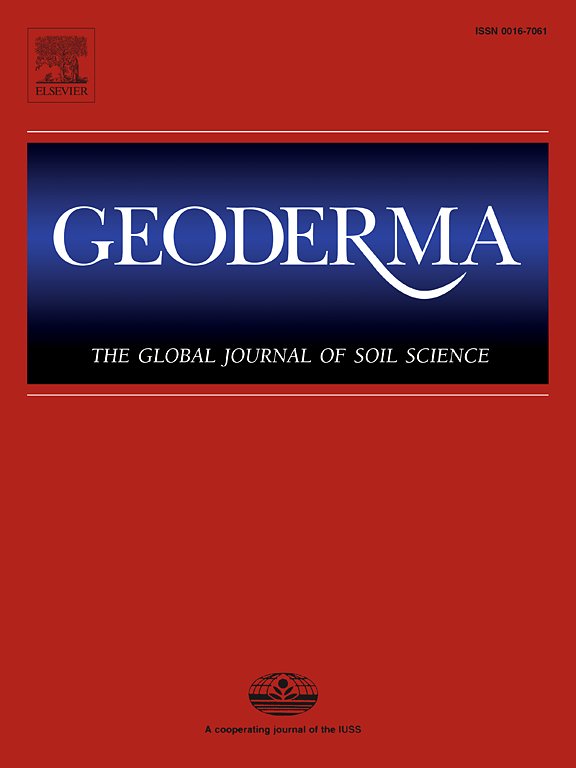A meta-analysis reveals earthworms as mutualists rather than predators of soil microorganisms
IF 5.6
1区 农林科学
Q1 SOIL SCIENCE
引用次数: 0
Abstract
Microorganisms constitute the largest biomass on Earth after plants, and earthworms are one of the main components of animal biomass. Both are critical drivers of soil functions and ecosystem services. Studies report either positive or negative effects of earthworms on soil microbial communities, leading to contrasting views on whether microorganisms serve as prey or mutualists for earthworms. This meta-analysis aimed to settle this debate, and examines how biotic and abiotic factors affect earthworm impacts on microbial abundance and diversity. Based on a selective search retaining only genuinely quantitative approaches, we kept 169 observations, showing that, on average, earthworms increased bacterial abundance by 16.5 % and fungal abundance by 31.4 %. Bacterial species richness rose by 8.5 % in the presence of earthworms, but fungal richness was not significantly affected. Epigeic and anecic earthworms had more notable effects than endogeics. Plant presence in experimental designs strongly amplified earthworms’ effects on bacterial (+30 %) and fungal (+97 %) abundances. The largest earthworm-induced effects were observed in carbon- and nitrogen-rich soils and at low pH, while the addition of organic matter reduced these effects. Comparing microbial abundance in earthworm casts to control units without earthworms revealed effect sizes two- to three-fold greater (for bacteria and fungi, respectively) than when using the soil surrounding earthworm casts as a control. Our meta-analysis demonstrates that, despite ingesting some microorganisms, earthworms have a net positive effect on their abundance, positioning them as mutualists rather than predators of bacteria and fungi.

荟萃分析显示蚯蚓是土壤微生物的互助者而非捕食者
微生物是地球上仅次于植物的最大生物量,而蚯蚓则是动物生物量的主要组成部分之一。两者都是土壤功能和生态系统服务的重要驱动力。有研究报告称,蚯蚓对土壤微生物群落有积极或消极的影响,这导致人们对微生物是蚯蚓的猎物还是互助者产生了截然不同的看法。本荟萃分析旨在解决这一争论,研究生物和非生物因素如何影响蚯蚓对微生物丰度和多样性的影响。根据只保留真正定量方法的选择性搜索,我们保留了 169 项观察结果,结果显示,蚯蚓平均使细菌丰度增加了 16.5%,真菌丰度增加了 31.4%。有蚯蚓存在时,细菌物种丰富度提高了 8.5%,但真菌丰富度并未受到显著影响。与内生蚯蚓相比,外生蚯蚓和内生蚯蚓的影响更为明显。实验设计中植物的存在极大地增强了蚯蚓对细菌(+30 %)和真菌(+97 %)丰富度的影响。在富含碳和氮的土壤中以及在低 pH 值条件下观察到的蚯蚓诱导效应最大,而添加有机物则会降低这些效应。将蚯蚓粪中的微生物丰度与没有蚯蚓的对照组进行比较,发现其效应大小(细菌和真菌)分别是以蚯蚓粪周围土壤为对照组的两到三倍。我们的荟萃分析表明,尽管蚯蚓会摄入一些微生物,但它们对微生物的丰度有净积极影响,使它们成为细菌和真菌的互助者而不是捕食者。
本文章由计算机程序翻译,如有差异,请以英文原文为准。
求助全文
约1分钟内获得全文
求助全文
来源期刊

Geoderma
农林科学-土壤科学
CiteScore
11.80
自引率
6.60%
发文量
597
审稿时长
58 days
期刊介绍:
Geoderma - the global journal of soil science - welcomes authors, readers and soil research from all parts of the world, encourages worldwide soil studies, and embraces all aspects of soil science and its associated pedagogy. The journal particularly welcomes interdisciplinary work focusing on dynamic soil processes and functions across space and time.
 求助内容:
求助内容: 应助结果提醒方式:
应助结果提醒方式:


